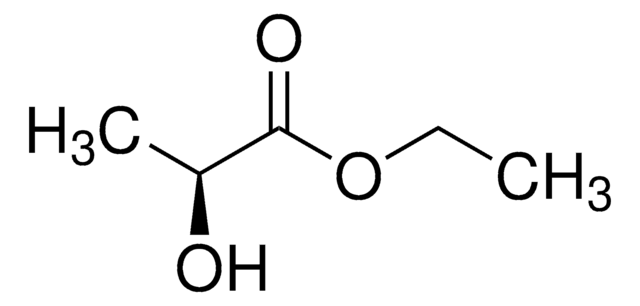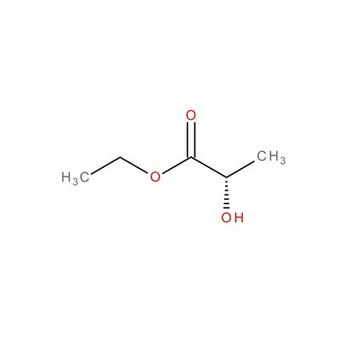77367
ElectroGreen® (−)-Ethyl L-lactate
≥99.0%
Synonym(s):
(−)-Ethyl (S)-2-hydroxypropionate, (S)-(−)-2-Hydroxypropionic acid ethyl ester, L-Lactic acid ethyl ester
About This Item
Recommended Products
Product Name
(−)-Ethyl L-lactate, ≥99.0%
vapor density
4.1 (vs air)
Quality Level
vapor pressure
2 mmHg ( 20 °C)
5 mmHg ( 30 °C)
Assay
≥99.0% (Sum of enantiomers, GC)
≥99.0%
form
liquid
optical activity
[α]20/D −10.5±1°, neat
autoignition temp.
752 °F
expl. lim.
1.5 %, 100 °F
impurities
≤0.1% water
evapn. residue
<0.01%
refractive index
n20/D 1.4130 (lit.)
n20/D 1.413
bp
154 °C (lit.)
mp
−26 °C (lit.)
density
1.034 g/mL at 20 °C (lit.)
cation traces
Ca: ≤0.01 mg/kg
Cr: ≤0.01 mg/kg
Cu: ≤0.01 mg/kg
Fe: ≤0.01 mg/kg
K: ≤0.01 mg/kg
Mg: ≤0.01 mg/kg
Mn: ≤0.01 mg/kg
Na: ≤0.03 mg/kg
Ni: ≤0.01 mg/kg
Pb: ≤0.01 mg/kg
SMILES string
C[C@H](O)C(OCC)=O
InChI
1S/C5H10O3/c1-3-8-5(7)4(2)6/h4,6H,3H2,1-2H3/t4-/m0/s1
InChI key
LZCLXQDLBQLTDK-BYPYZUCNSA-N
Looking for similar products? Visit Product Comparison Guide
Related Categories
Application
Signal Word
Danger
Hazard Statements
Precautionary Statements
Hazard Classifications
Eye Dam. 1 - Flam. Liq. 3 - STOT SE 3
Target Organs
Respiratory system
Storage Class Code
3 - Flammable liquids
WGK
WGK 1
Flash Point(F)
128.8 °F - closed cup
Flash Point(C)
53.8 °C - closed cup
Personal Protective Equipment
Choose from one of the most recent versions:
Certificates of Analysis (COA)
Don't see the Right Version?
If you require a particular version, you can look up a specific certificate by the Lot or Batch number.
Already Own This Product?
Find documentation for the products that you have recently purchased in the Document Library.
Customers Also Viewed
Our team of scientists has experience in all areas of research including Life Science, Material Science, Chemical Synthesis, Chromatography, Analytical and many others.
Contact Technical Service














